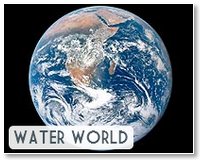| . |  |
. |
West Lafayette IN (SPX) May 05, 2011 Researchers have developed an aluminum alloy that could be used in a new type of mobile technology to convert non-potable water into drinking water while also extracting hydrogen to generate electricity. Such a technology might be used to provide power and drinking water to villages and also for military operations, said Jerry Woodall, a Purdue University distinguished professor of electrical and computer engineering. The alloy contains aluminum, gallium, indium and tin. Immersing the alloy in freshwater or saltwater causes a spontaneous reaction, splitting the water into hydrogen and oxygen molecules. The hydrogen could then be fed to a fuel cell to generate electricity, producing water in the form of steam as a byproduct, he said. "The steam would kill any bacteria contained in the water, and then it would condense to purified water," Woodall said. "So, you are converting undrinkable water to drinking water." Because the technology works with saltwater, it might have marine applications, such as powering boats and robotic underwater vehicles. The technology also might be used to desalinate water, said Woodall, who is working with doctoral student Go Choi.
A patent on the design is pending. "There is a big need for this sort of technology in places lacking connectivity to a power grid and where potable water is in short supply," he said. "Because aluminum is a low-cost, non-hazardous metal that is the third-most abundant metal on Earth, this technology promises to enable a global-scale potable water and power technology, especially for off-grid and remote locations." The potable water could be produced for about $1 per gallon, and electricity could be generated for about 35 cents per kilowatt hour of energy. "There is no other technology to compare it against, economically, but it's obvious that 34 cents per kilowatt hour is cheap compared to building a power plant and installing power lines, especially in remote areas," Woodall said. The unit, including the alloy, the reactor and fuel cell might weigh less than 100 pounds. "You could drop the alloy, a small reaction vessel and a fuel cell into a remote area via parachute," Woodall said. "Then the reactor could be assembled along with the fuel cell. The polluted water or the seawater would be added to the reactor and the reaction converts the aluminum and water into aluminum hydroxide, heat and hydrogen gas on demand." The aluminum hydroxide waste is non-toxic and could be disposed of in a landfill.
Share This Article With Planet Earth
Related Links School of Mechanical Engineering Water News - Science, Technology and Politics
 Filthy toilets a blight on Asian prosperity
Filthy toilets a blight on Asian prosperitySingapore (AFP) May 2, 2011 Fast-growing Asian economies may be flush with money but filthy toilets remain a blight across the region despite rising standards of living, with dire effects on poverty reduction and public health. Social activists say dismal sanitation facilities are causing preventable diseases in poor communities where people would readily spend money on a mobile phone - but not on a latrine. "I th ... read more |
|
| The content herein, unless otherwise known to be public domain, are Copyright 1995-2010 - SpaceDaily. AFP and UPI Wire Stories are copyright Agence France-Presse and United Press International. ESA Portal Reports are copyright European Space Agency. All NASA sourced material is public domain. Additional copyrights may apply in whole or part to other bona fide parties. Advertising does not imply endorsement,agreement or approval of any opinions, statements or information provided by SpaceDaily on any Web page published or hosted by SpaceDaily. Privacy Statement |